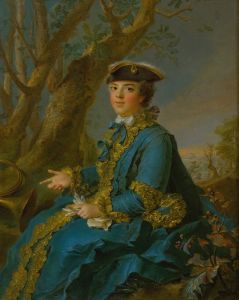
The marquise de Belestat
A hand-painted replica of Jean-Marc Nattier’s masterpiece The marquise de Belestat, meticulously crafted by professional artists to capture the true essence of the original. Each piece is created with museum-quality canvas and rare mineral pigments, carefully painted by experienced artists with delicate brushstrokes and rich, layered colors to perfectly recreate the texture of the original artwork. Unlike machine-printed reproductions, this hand-painted version brings the painting to life, infused with the artist’s emotions and skill in every stroke. Whether for personal collection or home decoration, it instantly elevates the artistic atmosphere of any space.
Jean-Marc Nattier (1685–1766) was a prominent French Rococo painter known for his portraits of the French aristocracy, often depicting his sitters in allegorical or mythological guises. One of his works, The Marquise de Belestat, exemplifies his refined style and mastery of portraiture during the 18th century.
This painting portrays the Marquise de Belestat, a member of the French nobility, in a manner typical of Nattier’s oeuvre. The artist was celebrated for his ability to blend realism with idealized beauty, and this work is no exception. The Marquise is depicted with a serene expression, her features rendered with delicate precision. She is dressed in elegant attire, characteristic of the Rococo period, with soft, flowing fabrics and intricate details that highlight her status and refinement. Nattier’s use of a muted, harmonious color palette and his skillful handling of light and shadow enhance the overall elegance of the composition.
Nattier often incorporated symbolic elements into his portraits, aligning his subjects with mythological or allegorical themes. While specific details about the symbolic content of The Marquise de Belestat are not widely documented, it is consistent with his practice to include such motifs to elevate the sitter’s image and convey a sense of timelessness. The background of the painting is typically understated, directing the viewer’s focus to the Marquise herself while subtly suggesting an air of sophistication and grace.
The exact date of the painting is not definitively recorded, but it likely falls within Nattier’s most productive period, during the mid-18th century, when he was a favored portraitist of the French court and aristocracy. His works were highly sought after for their ability to capture not only the likeness but also the social stature and personality of his subjects.
Today, The Marquise de Belestat is recognized as an example of Nattier’s contribution to the art of portraiture during the Rococo era. His works remain significant for their artistic quality and for their role in documenting the cultural and social milieu of pre-Revolutionary France. The painting is held in a private or institutional collection, though its current location and provenance are not widely publicized.
This portrait, like many of Nattier’s works, reflects the artistic trends and societal values of 18th-century France, offering insight into the aesthetics and ideals of the time.


















